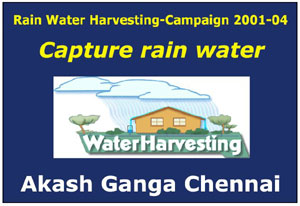
|
Lalitha Sridhar reports on rain-harvesting in Chennai

Chennai, February, 2002: "Chennai is a water-starved city, not a rain-starved one," says a leaflet which brings new hope to a population thirsting for sustenance. Traditionally, this south Indian city has depended to a large extent on groundwater for its water needs. But large-scale construction activity has led to large-scale depletion. Over the years, residents have dug deep to find water with bore wells going down going as much as 200 feet. In many neighbourhoods, particularly those close to the sea, saline contamination has resulted in what little water there becoming brackish.
To make matters worse, the last three years have also seen poor rainfall in the city with the result that the wells have gone dry and the bores spew brackish liquid. The situation worsened to the stage where the city has had to support itself year-round with water-tankers that supply water around town. Last summer was the worst in recent years, with the government using railway wagons for transporting water from as far as Neyveli. In addition to the huge cost of this exercise, only short-term relief is provided by such measures.
Update: Rain Centre model home opens in Chennai
Now experts maintain that the silver lining in the clouds which do not bring enough rain, lies in a simple, economical and demonstrably successful answer - Rainwater Harvesting (RWH). Chennai gets an average annual rainfall of 1,290 mm per year, which is more than the national average. The recent north-easterly monsoons were particularly good and brought 30 per cent more rainfall than usual. Each year, however, almost 90 per cent of the fresh water goes into sewers and storm water drains and some of it is lost by runoff and evaporation. At the same time, the fundamental issue of conservation by recycling effluent water also needs to be addressed. Sea water slowly seeping into indiscriminately exploited aquifers could cause irreversible damage. Controlling and safeguarding precious water reserves needs greater governance.
A group of concerned activists - of which Shekhar Raghavan, an RWH activist is a founder-member - has now come together under the aegis of the Akash Ganga Trust to popularize rainwater-harvesting. The groups runs information campaigns and helps install RWH systems. Besides distributing signboards which proclaim, "This house has a RWH system", the group intends to set up an independent unit installed with various methods of RWH to act as an educational exhibit-cum-research facility for water table studies.
This venture has the support of Shantha Sheela Nair, Secretary, Water Resources in the Chennai Corporation. Said Nair at Akash Ganga's inaugural meeting, "The government has made it mandatory to install rainwater harvesters in all new buildings. I followed this up by insisting that unless people showed me that something had been done, I would not provide them with water and sewer connections. My friends from the builders' lobby wanted to take me to court. They had a strong case: there was no precedent in case law which supported my stand."
But the results of this bold approach are showing. This monsoon, for the first time in 18 years, newspapers did not carry pictures of the arterial G N Chetty Road submerged in knee-deep water. It was one of the over 400 locations in which the Corporation had installed percolation pits near sidewalks for water harvesting. Indian Oil Corporation's huge office, which consumed 60,000 litres of water a day by pumping from four bores and buying two tankers of water daily, now has an RWH system. This company is now self-sufficient in its water needs, the quality of water has improved tremendously, the car park no longer floods during the monsoons and the system has paid itself off already.
There are other examples too. Alacrity Foundations, a reputed blue-chip building company has made RWH a mandatory part of its project proposals; the 600-acre Anna University campus no longer pays a water bill of Rs 600,000 (1 US$=Rs 48) every month while its neighbour, the prestigious Indian Institute of Technology (IIT), had to postpone exams last semester and shut down the campus for want of water. Sriram Rammohan's industrial unit employs over 400 workers who had no option but to use water from wells that had been contaminated by over-exploitation and effluents. "Now with RWH, the King Institute certified our water as potable after just the summer showers - our staff couldn't believe it" says Rammohan.
In an attempt to take the movement further, Anna University's engineering students do house-to-house canvassing in residential areas for RWH. Over 6,000 households have benefited from superior and surplus water with a system that pays itself off in less than a year. In the perennially dry Padmanabha Nagar, a citizen's movement has seen 80 per cent of the houses install RWH. Some of them have not had to buy water for over two years.
It is not raining only good results, though. There are 350,000 plots of residential land and the number covered by RWH is pitiably small. Vast stretches of public spaces pose another serious concern. Harvesting remains a privilege outside the economic reach of hutments and slums. And even those who belong to the more well-off sections of society have not exploited the benefits of RWH as much as they could have. Via a small network of percolation pits and interconnected pipes, a complex of six flats (real estate worth over Rs 10 million) would just need around Rs 20,000 to take care of its future water needs. And yet, says Raghavan, "It has been an uphill task convincing people to invest in the system. The challenge is that of educating the educated."
Lalitha Sridhar
February 2002
Lalitha Sridhar is a freelance development journalist, based in Chennai. This article on India Together is provided by the Women's Feature Service.